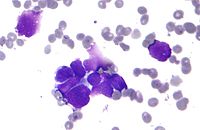
Photo from wikipedia
Knowledge of ectopic Cushing’s syndrome (CS) due to thymic neuroendocrine tumours (NETs) comes from short series or single cases. Our aim is to perform a systematic review using PubMed, Embase,… Click to show full abstract
Knowledge of ectopic Cushing’s syndrome (CS) due to thymic neuroendocrine tumours (NETs) comes from short series or single cases. Our aim is to perform a systematic review using PubMed, Embase, Scopus, Ovid Medline and Biosis Previews of all cases with ectopic CS due to thymic NETs reported in the last 40 years and describe one illustrative patient attended in our institution. Search of literature: From 162 patients, 58.6% were male and mean age was 34.6 ± 13.9 years-old. Median of symptoms until diagnosis was 6 [2–24] months and 62% had aggressive CS. Imaging was positive in 93.7% (chest X-ray), 97.8% (computed tomography), 80.7% (somatostatin receptor scintigraphy) and median tumour size was 47 [25–68.5] mm. At presentation, 18% had localized disease, 26.2% locally invasive and 55.7% advanced. Eighty-eight present underwent surgery and histological subtypes were atypical (46.7%), typical (30.4%) and carcinoma (21.7%). Tumour persisted or recurred in 70.1%, 63% received radiotherapy and 45.2% chemotherapy. Follow-up median was 26.6 [14.5–57.5] months and mortality was reported in 35.8% with median survival of 38 [19–60] months. MEN-1 mutation was referred in 3.1%. Comparatively, carcinomas had aggressive CS more frequently while atypical showed advanced disease more often. In conclusion, thymic NETs causing ectopic CS are presented as aggressive hypercortisolism in the middle aged population. The disease is commonly extended at diagnosis and persists or recurs after surgery in most patients with a short term high mortality.
Journal Title: Reviews in Endocrine and Metabolic Disorders
Year Published: 2021
Link to full text (if available)
Share on Social Media: Sign Up to like & get
recommendations!